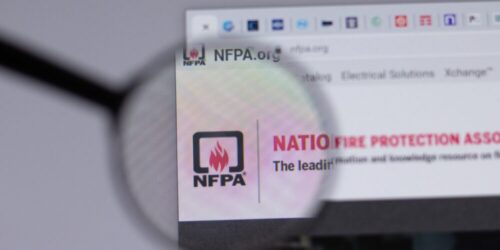
7.11.23 – SSI
NFPA began working on new Standard for the Installation of Fuel Gases Detection and Warning Equipment in 2021.
In the June 2021 Fire Side Chat, I discussed a new standard that the National Fire Protection Association (NFPA) was in development of. This was NFPA 715, Standard for the Installation of Fuel Gases Detection and Warning Equipment.
The standard has now been completed as released with a 2023 edition date.
In my 2021 article, I reviewed the scope of the document and the driving force behind its development. While the standard is now published, it has not yet been adopted by the model codes as promulgated by the NFPA or the International Code Council (ICC). I do expect this to occur during the next cycle of the model codes.
The standard has nine chapters and four annexes, as follows:
- Chapter 1, Administration
- Chapter 2, Referenced Publications
- Chapter 3, Definitions
- Chapter 4, Fundamentals of Fuel Gas Detection Systems
- Chapter 5, Protected Premises Fuel Gas Detection Systems
- Chapter 6, Notification Appliances for Fuel Gas Detection Systems
- Chapter 7, Off-Premises Signal Transmission
- Chapter 8, Inspection, Testing, and Maintenance
- Chapter 9, Single- and Multiple-Station Alarms and Household Fuel Gas Detection
- Annex A, Explanatory Material
- Annex B, Dangers and Properties of Fuel Gases
- Annex C, Guidelines for Emergency Responders
- Annex D, Informational References
The layout of the standard should look familiar to anyone who uses NFPA 72, The National Code for Fire Alarm and Signaling Systems. A large portion of the requirements that are within NFPA 715 are extracted from NFPA 72.
This is not NFPA 72, so an individual who may be designing, installing or testing a system in accordance with NFPA 715 does need to know the differences between the two standards.
Chapter 4 covers in part the power requirements for a fuel gas detection system. There is a different requirement for standby power. While within NFPA 72 states there is to be capacity for 24 hours of standby and then either five or 15 minutes in alarm with all notification appliances active, NFPA 715 requires that at the end of the 24 hours of standby, the system can still provide power to the notification appliances for 12 hours.
If, however, the system is supervised by a monitoring station, the 12 hours may be reduced to five minutes. The reason behind this is if the building is not occupied at the time that alarm is activated, the notification appliances would still be sounding when occupants may return to the building during a workweek. If the system is being supervised by an offsite monitoring center, the assumption is a responsible party will be notified.
More From NFPA 715
There is no chapter within 715 dedicated to the siting of fuel gas detectors. Within Chapter 5, Section 5.8.5.3.1 offers the prescriptive requirements for where fuel gas detectors are to be installed. Some variances between the location of smoke detectors and alarms and fuel gas detectors and alarms are that they must be installed per the manufacturer’s published instructions.
For natural gas, they are to be installed within 12 inches of the ceiling, while for liquefied petroleum gas (LP0Gas) they are to be sited within 18 inches of the floor. Additional requirements are within 5.8.5.3.1.
Fuel gas detectors should activate when the concentration threshold is at or below 25% of the Lower Explosive Limit (LEL). Notification of an alarm should be through the protected premises unless the system is being supervised by a monitoring station or a constantly attended on site location. In this case, the notification may be limited to the area in which the fuel gas alarm signal was initiated.
The audible signal is to be different from any other signal that may be generated within the protected premises. It may be either a continuous or temporal signal. The temporal signal is not to be a temporal three (fire alarm) or temporal four (carbon monoxide) but should sound for a minimum of three minutes unless the system is reset of silenced. If the notification appliance is within a sleeping area, it is to produce a 520Hz low frequency sound.
The color of a strobe for these systems is white or clear. The notification appliance may be labeled as FUEL GAS as long as the appliance is not being used in combination with other systems in the protected premises.
Currently, 715 is not under the direction of the NFPA 72 Correlating Committee, such as NFPA 720, Standard for the Installation of Carbon Monoxide (CO) Detection and Warning Equipment was before it was merged into NFPA 72. As 715 becomes adopted within the model codes, installers of life-safety systems should become familiar with it as the requirement for these detectors will increase.
About the Author

SHANE CLARY, SSI Contributor
Shane Clary, Ph.D., is Security Sales & Integration’s “Fire Side Chat” columnist. He has more than 37 years of security and fire alarm industry experience. He serves on a number of NFPA technical committees, and is vice president of Codes and Standards Compliance for Pancheco, Calif.-based Bay Alarm Co
